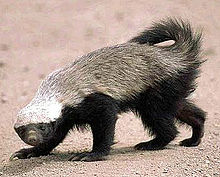Honey Badger
"Ratel" redirects here. For other uses, see Ratel (disambiguation).
Honey Badger
Fossil range: middle Pliocene - Recent Conservation status
Conservation status
Scientific classificationKingdom:
AnimaliaPhylum:
ChordataClass:
MammaliaOrder:
CarnivoraFamily:
MustelidaeSubfamily:
MellivorinaeGenus:
Mellivora
Storr, 1780Species:
M. capensis
Geographic distribution
The
Honey Badger (
Mellivora capensis), also known as the
Ratel, is a
monotypic species of
mustelid native to
Africa, the
Middle East and the
Indian Subcontinent. Despite its name, the honey badger does not closely resemble other
badger species, instead bearing more anatomical similarities to
polecats. It is classed as
Least Concern by the
IUCN due to its extensive range and general environmental adaptations. It is a primarily carnivorous species, and has few natural predators due to its thick skin and ferocious defensive abilities.
Contents
[hide][edit] Etymology
Ratel is an
Afrikaans word, possibly derived from the
Middle Dutch word for rattle, honeycomb (either because of its cry or its taste for honey). In English it is accented on the first syllable, with the "a" is pronounced either as in "rate",
/ˈreɪtəl/, or as "father", /ˈrɑːtəl/.
[2]
[edit] Taxonomy


Skeleton from the
Muséum national d'histoire naturelle
The honey badger is the only member of the genus
Mellivora. Although it was initially assigned to the badger group in the 1860s, it is now generally accepted that they bear very few similarities to the subfamily
Melinae, instead being much closer to the
marten family. Differences between
Mellivora and
Melinae include a different dentition. Though not related to the
wolverine, which is a large-sized deviant of the marten family, the honey badger can be considered an analogous form of polecat. The species first appeared during the middle
Pliocene in Asia. Its closest relation was the extinct genus
Eomellivora, which is known from the upper
Miocene, and evolved into several different species throughout the whole Pliocene in both the
Old and
New World.
[3]
[edit] Subspecies
As of 2005
[update],
[4] 12 subspecies are recognised. Points taken into consideration in assigning different subspecies include size and the extent of whiteness or greyness on the back.
[5]
Subspecies

Trinomial authority

Description

Range

Synonyms
 Cape ratel
Mellivora capensis capensis
Cape ratel
Mellivora capensis capensis 
Schreber, 1776
South and southwestern Africa
mellivorus (G. [Baron] Cuvier, 1798)
ratel (Sparrman, 1777)
typicus (A. Smith, 1833)
vernayi (Roberts, 1932)
Ethiopian ratel
Mellivora capensis abyssinicaHollister, 1910
EthiopiaTurkmenian ratel
Mellivora capensis buechneriBaryshnikov, 2000Similar to the subspecies
indica and
inaurita, but is distinguished by its larger size and narrower postorbital constriction
[6]TurkmeniaLake Chad ratel
Mellivora capensis concisa 
Thomas and Wroughton, 1907The coat on the back consists largely of very long, pure white bristle-hairs amongst long, fine, black underfur. Its distinguishing feature is the fact that unlike other subspecies, it lacks the usual white bristle-hairs in the lumbar area
[7]Sahel and
Sudan zones, as far as
Somalilandbrockmani (Wroughton and Cheesman, 1920)
buchanani (Thomas, 1925)
Black ratel
Mellivora capensis cottoni
Lydekker, 1906The fur is typically entirely black, with thin and harsh hairs
[7]Ghana, northeastern
Congosagulata (Hollister, 1910)
Nepalese ratel
Mellivora capensis inauritaHodgson, 1836Distinguished from
indica by its longer, much woollier coat and having overgrown hair on its heels
[8]Nepal and contiguous areas east of it
Indian ratel
Mellivora capensis indica 
Kerr, 1792Distinguished from
capensis by its smaller size, paler fur and having a less distinct lateral white band separating the upper white and lower black areas of the body
[9]Western
Middle Asia northward to the
Ustyurt Plateau and eastward to
Amu Darya. Outside the
former Soviet Union, its range includes
Afghanistan,
Iran (except the southwestern part), western
Pakistan and western
Indiamellivorus (Bennett, 1830)
ratel (Horsfield, 1851)
ratelus (Fraser, 1862)
White-backed ratel
Mellivora capensis leuconota 
Sclater, 1867The entire upper side from the face to half-way along the tail is pure creamy white with little admixture of black hairs
[7]West Africa, southern
Morocco, former
French CongoKenyan ratel
Mellivora capensis maxwelliThomas, 1923
KenyaArabian ratel
Mellivora capensis pumilioPocock, 1946
Hadhramaut, southern
ArabiaSpeckled ratel
Mellivora capensis signata 
Pocock, 1909Although its pelage is the normal dense white over the crown, this pale colour starts to thin out over the neck and sholders, continuing to the rump where it fades into black. It possesses an extra lower molar on the left side of the jaw
[7]Sierra LeonePersian ratel
Mellivora capensis wilsoniCheesman, 1920Southwestern Iran and
Iraq